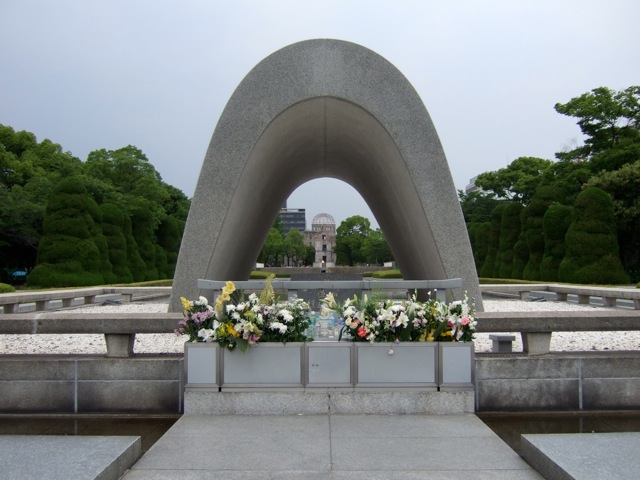
leaving Hiroshima and Miyajima
This time I’m on the misty blue waters of the Inland sea, on a ferry between Hiroshima and Matsuyama. My conference starts tomorrow. To the left and to the right of me are many small forested islands; ahead in the distance on the horizon I can see a vague outline of coastline.
I’ve just spent on day in Hiroshima and one day exploring the Island of Miyajima. Miyajamia is famous for the beautiful red torii of Itsukushima shrine and Hiroshima is famous for — well, you know what Hiroshima is famous for.
I visited the area around the Peace Park, where the monuments and museums are, the afternoon that I arrived from Kanzawa. My hotel’s sole virtue was that it was very close to the Peace Park, but it was a much less interesting place than those “minshuku” that I stayed at in Kanzawa and Nikko.
The museum in the Peace Park documents in a fairly balanced way the events which lead to the atomic bombing of Hiroshima; there were a lot worse things which could be said about why the allies decided to destroy a Japanese city as opposed to a German one which were left unsaid.
The museum has a large collection of artefacts recovered from the city, lunch boxes with the remains of carbonised food inside, watches stopped at the exact instant of the bombing. For each of these items, their story is detailed, the human life that was extinguished with the object. The effects of the bomb were described in unflinching detail. Only five photographs were ever taken in the city on the day of the bombing, I learned, by a journalist who entered the city that afternoon. He could only take those five photographs before he was overcome by emotion and horror, paralysed by the apocalyptic sight before him.
I spent a few hours in the museum, listened to all the audio commentary, looked at all the exhibits. Then I left for the park and walked to the cenotaph in the centre of the park. Standing before the memorial for the victims of the explosion, a curving, undulating arch, one sees in a direct line under the arch the burning flame, the flame that was lit that day in August in 1945, and beyond that charred structure of the “A-bomb dome”, one of the few buildings left standing after the explosion. It was only at that instant that I realised, fully, that those events described in the museum didn’t happen in some abstract place far away. They happened here, on the ground I was standing on.

Some comments I’ve read try to contextualise the deaths in Hiroshima by saying, for example, that one one night of bombing in Tokyo many more people lost their lives. But in Hiroshima so many people died in the instant the bomb exploded. 70,000. In five seconds every building with a kilometre of the fireball were annihilated. Such terrible destructive power had never been seen before.
At the same time, horribly, it was treated as a scientific experiment. In the instant before the bomb was dropped, people reported seeing several small white parachutes falling from the Enola Gay. These were in fact radio transmitter probes designed to measure the atmospheric pressure in the vicinity of the bomb site. After Hiroshima had been selected as a target for a possible atomic bombing, no conventional bombing was carried out over the city so that the effects of atomic bombing could be better understood.
Hiroshima, thankfully, bears the weight of it’s terrible history very lightly. A beautiful warm ocean breeze permeates the city, and the evening the streets are buzzing with life and activity. I ate in two fine “okonomiyaki” restaurants both evenings I was there, a local speciality comprising many vegetables and seafood fried on a hot-plate before the customers. I am sure people ate okonomiyaki in Hiroshima on that day in August, too.
2 thoughts on “leaving Hiroshima and Miyajima”
I really don't know if I could survive even a visit to Hiroshima memorial today… This very weekend, I had a chance to see Shohei Imamura's movie "Black rain" (1988):
"Mr and Mrs Shizuma, and their niece Yasuko, make their way through the ruins of Hiroshima, just after the atomic bomb has dropped. Five years later, Yasuko is living with her aunt and uncle, and her senile grandmother, in a village containing many of the bomb survivors. Yasuko does not appear to be affected by the bomb, but the Shizuma's are worried about her marriage prospects, as she could succumb to radiation sickness at any time." (Written by Will Gilbert)
And I was much moved of course while watching this movie. It's really a masterpiece (in B&W) that let us feel what it was like having survive Hiroshima bombing…
I think that, one day, I'll have to go to Hiroshima.
Anyway, as usual, I like your writing. Thanks for sharing with us your travels!
John Seagull
PS Your picture of the Memorial is great…
JS